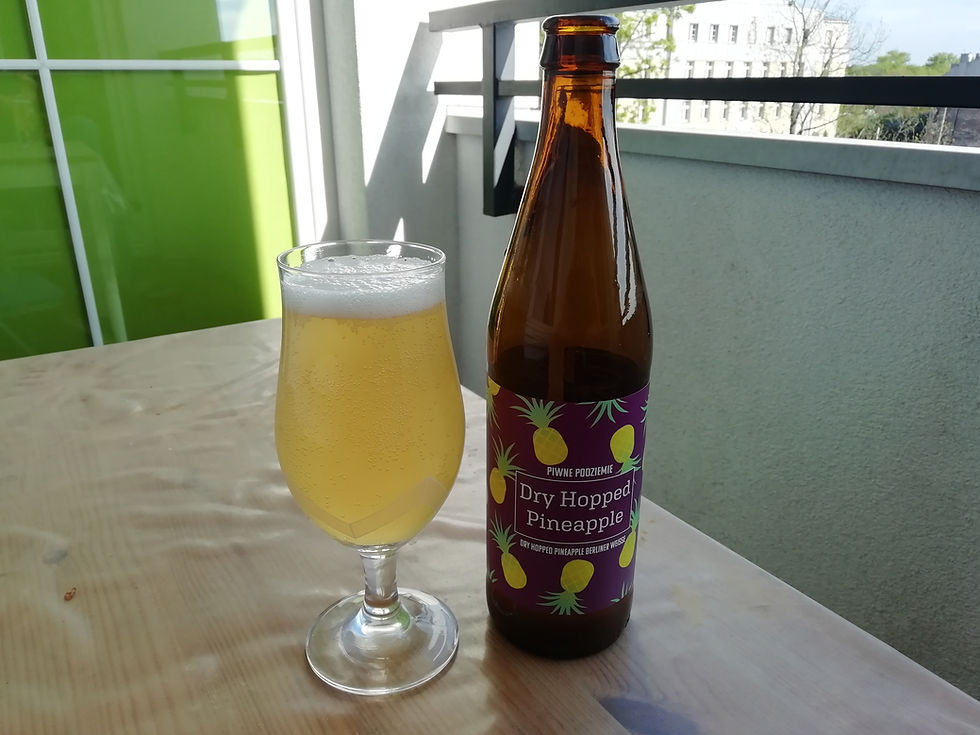Balcony beer: Champagne of the North - Dry Hopped Pineapple, Piwne Podziemne
- Pibeno
- May 15, 2020
- 3 min read
The beautiful summer weather of last week was begging for a refreshing drink. Thanks to my trip to the beer shop, I had just the right beverage for this sunny weekend evening: A dry-hopped and pineapple infused Berliner weisse. “A what now?” I hear you asking. The beer is definitely not as daunting as the name of its style, trust me. Hear me out.
First of all the style: Berliner weisse. As the name suggests, the origins of this top-fermented sour wheat ale lie in the region of the German capital, where I remember having my very first one about 5 years ago. The beer style became popular in the 19th century. When Napoleon’s soldiers were in the region, they called it the ‘champagne of the North’. Traditionally, the beer is nicely tart and refreshing, and thanks to its sour and effervescent character, it serves as a real thirst quencher during hot summer days.

The hops used to brew a BW, only have a supporting role and hardly ever stand out in the beer's flavour. The nice acidity is generally the effect of lactobacillus yeast, which makes the beer ideal for combining with fruits during the brewing process. This is what craft brewers have been doing the past few years, after reviving the beer from the nearly dead, after the style had gradually lost popularity during the 20th century. But be aware, the BW is back and is a frequent experiment for many craft beer brewers of this time.
But then, dry-hopping. To understand what is so special about this, I’ll have to explain briefly where the hops come in during the regular brewing process. Brewing begins by mashing grains and water at different temperatures to dissolve the grain’s sugars into the water. The result after filtering is mostly a brownish liquid, an extract called ‘wort’. During the next step, the wort is being boiled for at least an hour. The brewer throws in hops to add bitterness and aroma to this ‘pre-beer’. It is only after a 1-hour boil that the hops release their bitter compounds of lupulin. After the boil, the yeast is added to transform the sugars in the extract into alcohol and CO2. And boom! A beer is born. If only it were that easy...
When a beer style contains the letters ‘DH’, this means that it has been ‘dry-hopped’. For dry-hopping, brewers add hops to the extract after the boil (before, during or after fermentation). Since the boil is done, the hops won’t release any bitterness, but they will enhance the aroma of the beer. Sometimes a beer is being dry-hopped twice, which will give it the epithet ‘DDH’, which stands for double dry-hopped. These drinks are usually aromatic bombshells!
So I was leaning back in the sun on my balcony, and popped the bottle of Dry-Hopped Pineapple (my inner grammar nazi had to put a hyphen there) of the guys of Piwne Podziemne. This brewery from the city of Chełm in the far east of Poland, had already left a few good impressions on me with other beers of theirs. I was curious if they could get me rid of the idea that most Polish fruit-infused beers should belong in a juice box. I haven’t been very lucky up to now.
At first glance, the beer looked very champagne-like indeed, with lots of small bubbles rising to the surface and a small head that disappeared quite quickly after pouring the beer. The colour was lighter than I was used to of other Berliner weisses I had before. This was probably due to the addition of pineapple pulp, but it only added to the feel of having sparkling wine in my glass.
The smell was all pineapple with some slightly citrusy and grassy notes of the dry-hopping process. The flavour is nicely tart and well-balanced with the exotic fruitiness of the pineapple. It is a light and easily drinkable beer that leaves a bit of lactic stickiness in your mouth when swallowing. The finish is also bone-dry and clean as a whistle. The sourness made some shivers run down my spine and left me craving for something to eat. Very pleasant balcony beer before dinner indeed!
So a nice German refreshing delight this time. I have another one in my fridge that is similar, but also slightly different. Stay tuned!






Comments